This Cajun Seafood Gumbo with Shrimp and Crab recipe is filled with the bold and irresistible flavors of the Bayou. This classic Louisiana-style stew combines succulent shrimp, tender crab meat, and a blend of flavorful herbs. The velvety roux-based broth is infused with the Holy Trinity of vegetables and Cajun spices for immense flavor.
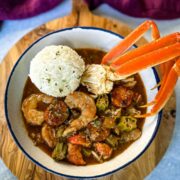
Want to save this recipe for later?
This post contains affiliate links. Please read my full disclosure here.
Table of Contents
Key Ingredients
- Andouille sausags
- Butter
- Flour
- Green Peppers
- Celery
- Onions
- Garlic
- Okra
- Broth
- Shrimp
- Crab
- Cajun Spices
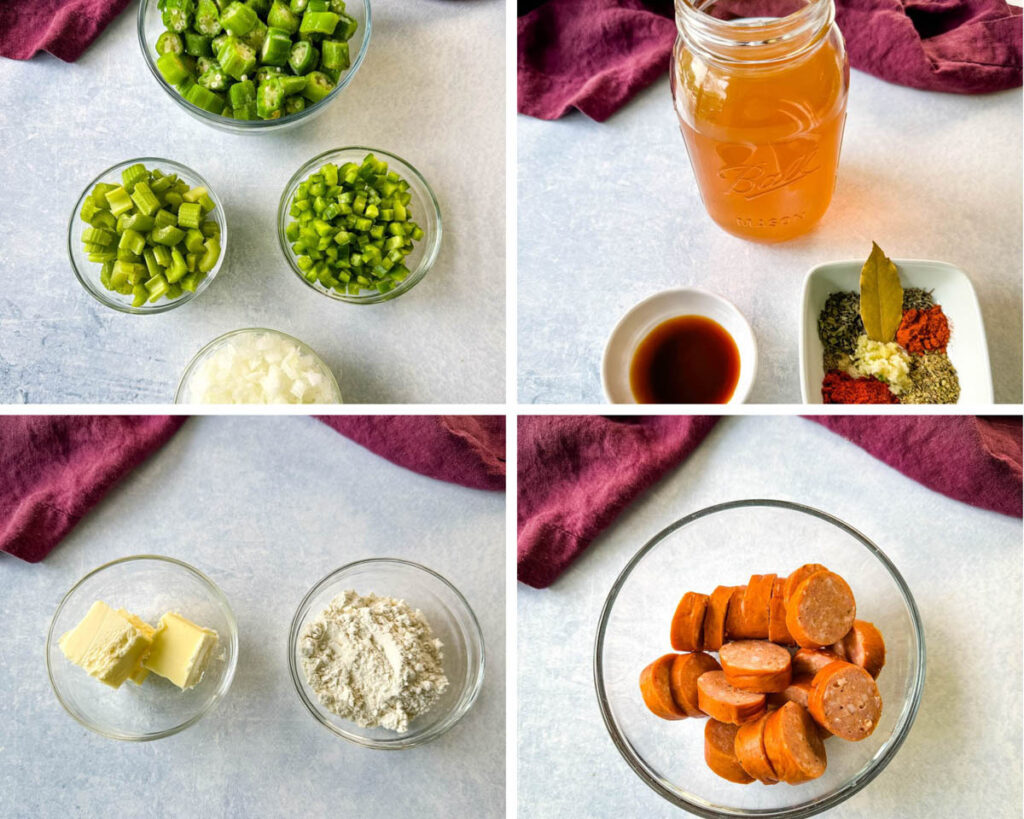
What is Gumbo
It's a popular and flavorful dish that originated in Louisiana, particularly within the Creole and Cajun communities. It is a hearty stew that combines very distinct ingredients to produce an amazing, comforting flavor.
It starts with a roux, a mixture of flour and fat (often oil or butter), which is slowly cooked until it reaches the desired color, ranging from light to dark brown. The roux provides the base and thickens the gumbo.
From there, the Holy Trinity vegetables are added along with Cajun or Creole Seasonings, and a flavorful broth or stock. A Seafood Stock works great in this version of the dish.
And last the protein, which typically consists of seafood or chicken and smoked andouille sausage.
Holy Trinity Ingredients
You must use these in true gumbo. The "Holy Trinity" is a term used in Cajun and Creole cooking and includes three ingredients: onions, bell peppers, and celery. These are considered the foundation of many dishes and are used to create a flavorful base for gumbo, jambalaya, dirty rice, grits, and more.
What Type of Seafood to Use
I like to use shrimp, crab, and lobster. You can use whatever you like.
- Shrimp: Shrimp is a classic and essential ingredient in seafood gumbo. It adds a sweet and savory flavor and a tender texture to the dish.
- Crab: Lump crab meat or crab claws are another popular addition. They add a delicate sweetness and richness to the broth.
- Lobster Meat or Lobster Tail: For an indulgent twist, lobster or lobster tail can be included in for a touch of luxury.
- Crawfish: Crawfish tails can be used to provide a classic Louisiana touch and slightly different flavor profile and texture compared to shrimp and crab.
- Oysters: Oysters add a briny and distinctive taste.
- Clams and Mussels: These will add more depth to the gumbo broth and provide additional seafood variety.
- Fish: Firm white fish, such as cod, catfish, or grouper will add substance and flavor.
- Scallops: Scallops are a delicate and tasty seafood option that can enhance the overall taste and texture.
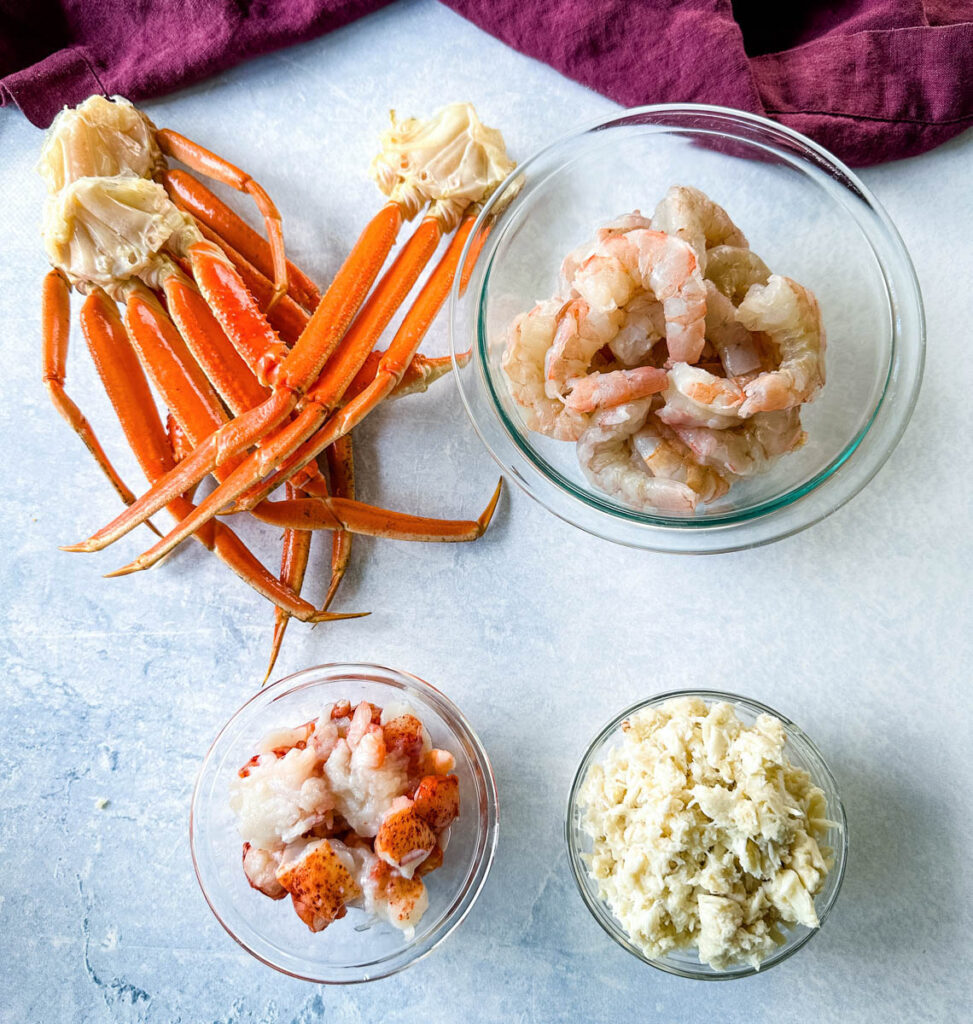
How to Make a Roux
The roux is the most important part of the dish. If you have Southern roots, you know a good roux when you see one. It's usually deep brown, sometimes peanut butter brown. Either way, it's usually a point of contention and debate among Southerners.
The roux is the thickening agent for the recipe and calls for equal parts flour and oil (typically butter or olive oil). You will also need a pot and a whisk or wooden spoon.
- Heat the butter in a pan or skillet over medium-low heat.
- Once melted, gradually whisk in the flour, stirring constantly to prevent lumps from forming.
- Continue to stir (without stopping), until it reaches the desired color. A peanut butter roux will take around 10-15 minutes and a dark roux can take around 15-20 minutes.
It's important to keep an eye on the roux while it cooks, as it can burn quickly if left unattended. A burned roux will have a bitter taste.
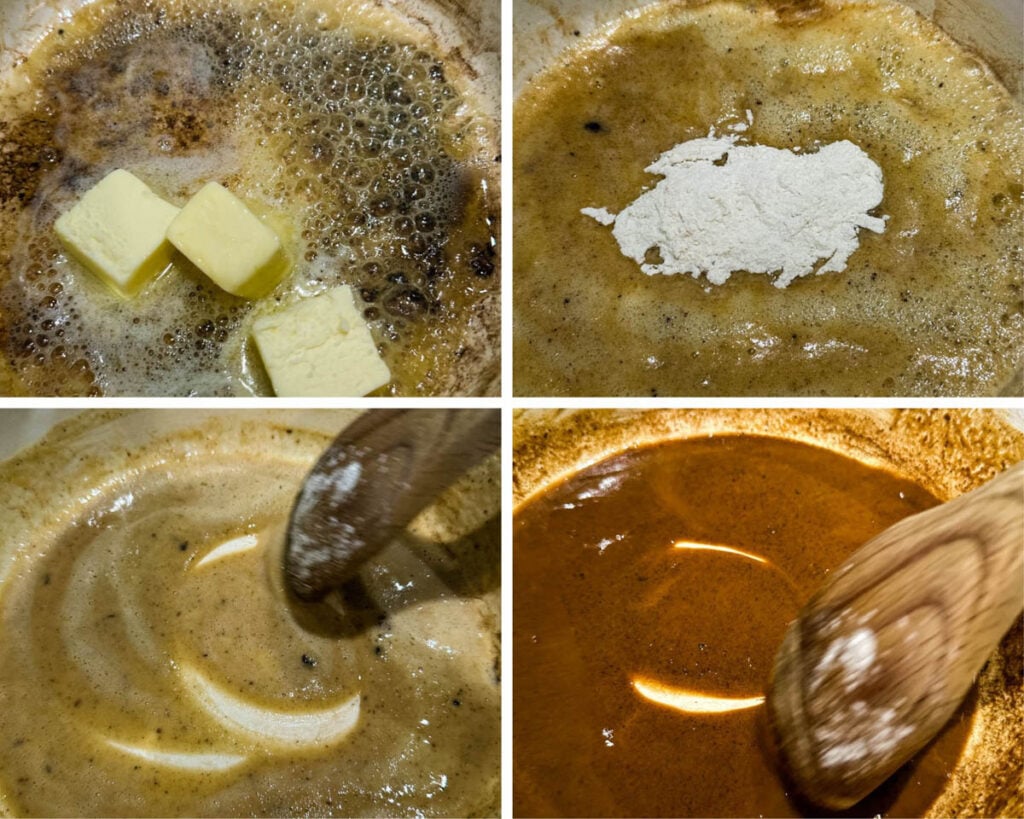
Okra
I often receive questions about okra (typically from non-Southerners) regarding substituting or omitting it from the dish.
Okra has a long history of cultivation in Africa, where it is believed to have originated. During the transatlantic slave trade, okra seeds were brought to the United States, particularly in the Southern states, where they thrived in the warm and humid climate.
You either love or hate it. Okra is well-known for its distinctive texture, which can be described as "slimy." The texture is a result of the presence of a substance called mucilage, which is a gel-like substance found in the pods of the okra plant.
When okra is cooked or comes into contact with moisture, the mucilage is released, giving the vegetable its characteristic slimy texture. When used in gumbo, it's one of the key ingredients to give the dish a thick texture, coupled with the roux.
You can omit it if you wish. It will alter the texture of the dish and also take away from the authentic appeal.
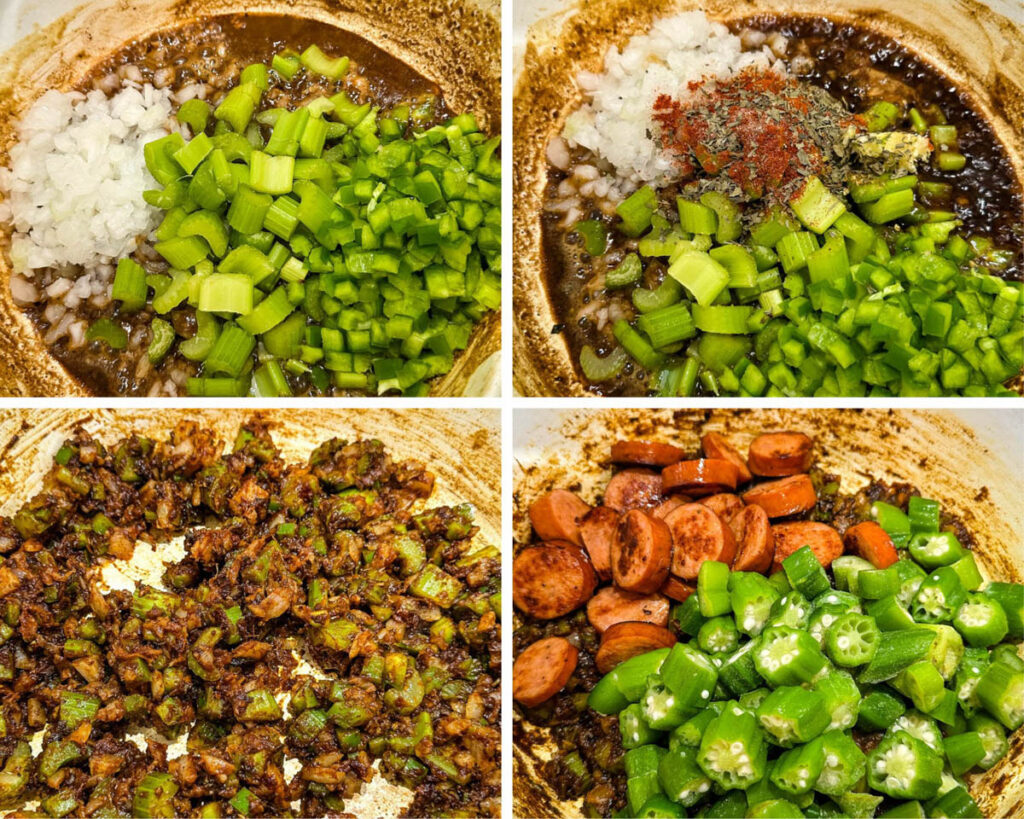
What Spices to use/Is it Spicy?
The recipe uses dried basil, oregano, thyme, a bay leaf, and Cajun Seasoning.
Cajun seasoning is typically spicy. It contains cayenne pepper and other spices that can add heat to dishes. The level of spiciness can vary depending on the brand or recipe of the seasoning, so some Cajun seasonings may be milder than others.
I like to make my own Homemade Cajun Seasoning and Rub for this reason. It allows you to directly control the spice. It’s always a good idea to start with a small amount and adjust to your taste preferences. If you’re sensitive to spicy food, you can also look for Cajun seasoning blends that are labeled as mild or use less of the seasoning in your cooking.
How to Make Cajun Seafood Gumbo
Detailed measurements and full instructions can be found in the recipe card at the bottom of this post.
- Add sliced sausage to a Dutch oven or stockpot on medium-high heat. Cook.
- Add the butter to the pot on medium heat. While it melts add the flour in 3 phases.
- Continue to stir until the roux turns deep brown.
- Add green peppers, celery, onions, Worcestershire sauce, and spices (except the bay leaf) to the roux. Stir and cook for 8-10 minutes until the veggies are soft.
- Add in broth and okra. Stir. Adjust the heat on the stove and bring the pot to boiling.
- Stir and add a bay leaf. Cover the pot and simmer.
- Remove the lid from the pot and add seafood. Cook for 2-3 minutes.
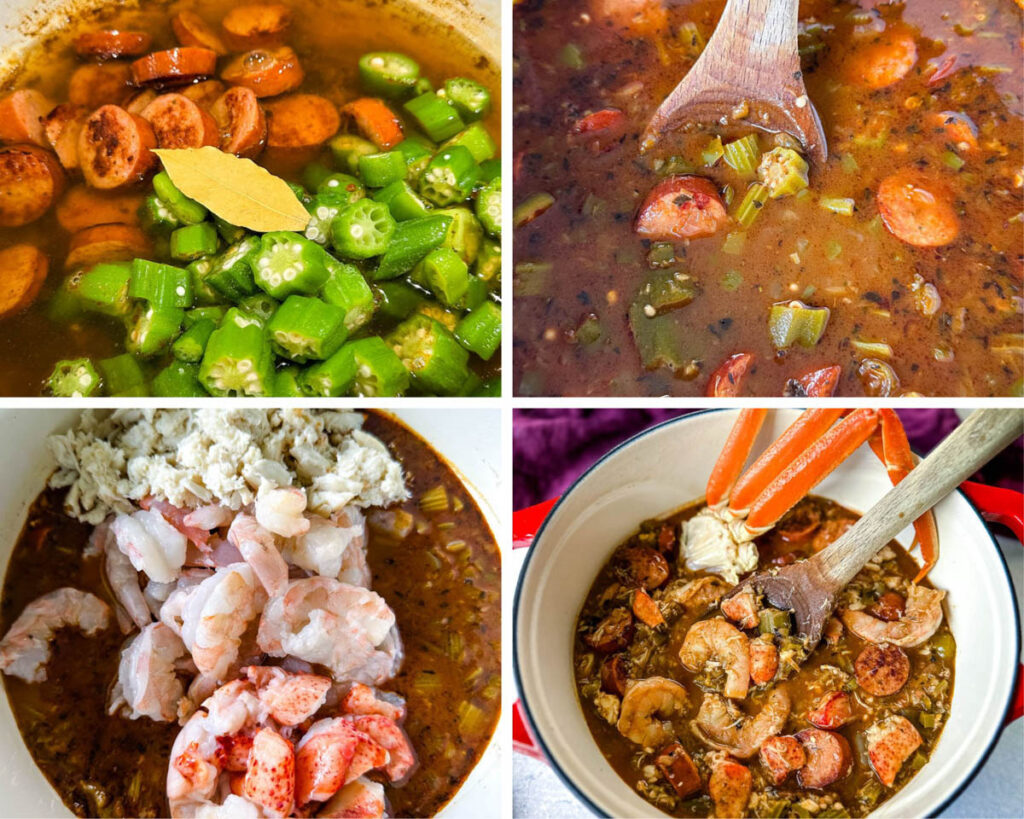
What Type of Pot to Use
It's best to use a large, heavy-bottomed pot that can hold a significant amount of liquid and ingredients. Here are two great options for pots to use when making gumbo:
- Dutch Oven: A Dutch oven is an ideal choice for cooking gumbo. I use a 6 quart. It's a heavy, thick-walled pot made of cast iron or enameled cast iron. The even heat distribution and excellent heat retention properties of the Dutch oven make it perfect for simmering the gumbo slowly and allowing the flavors to meld.
- Stockpot: A large stockpot is another excellent option for making gumbo. Look for a stockpot that is at least 6 quarts in size to accommodate the volume of the ingredients easily. Stainless steel or aluminum stockpots with a thick, heavy base work well for even heat distribution.
Both the Dutch oven and stockpot should have a well-fitted lid to trap steam and maintain the ideal temperature while cooking. The depth of the pot is crucial as gumbo tends to have a lot of liquid, especially when making larger batches.
Gumbo is a one-pot dish, so you want to make sure you have enough space in your pot to accommodate all the ingredients, including the broth, proteins, vegetables, and any other add-ins you choose.
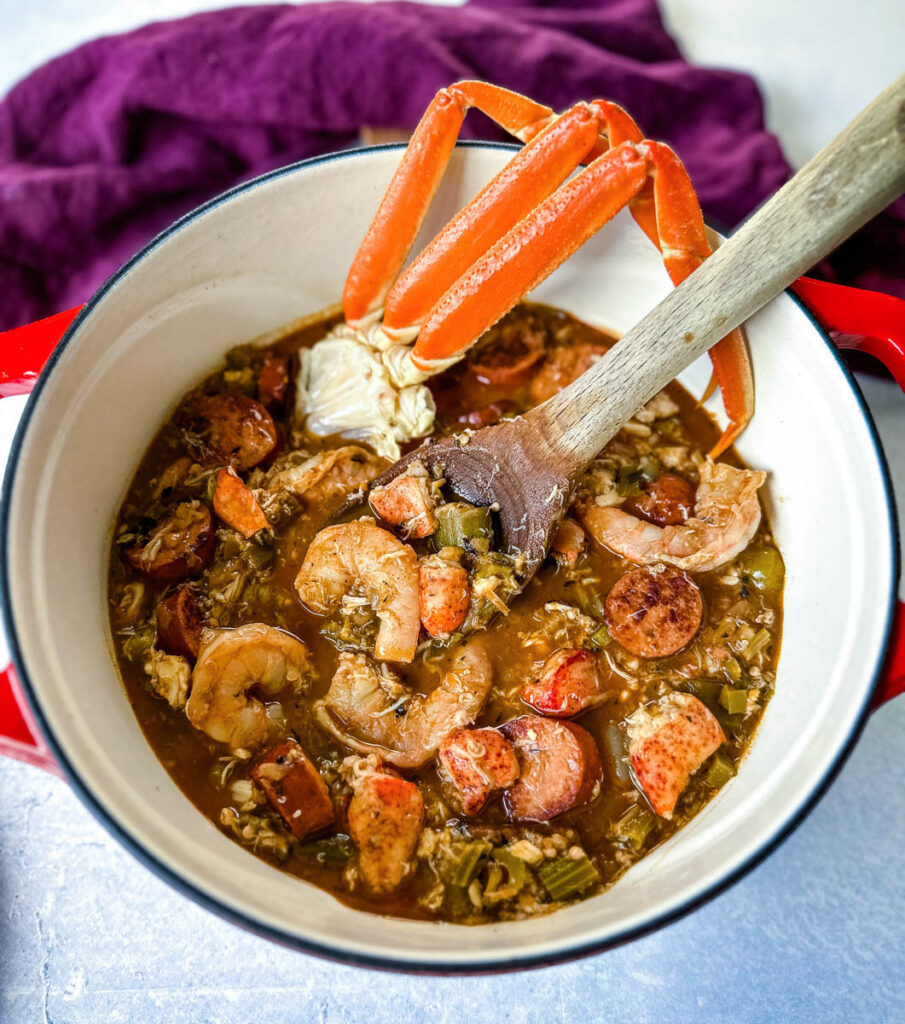
Additional Add-Ins/Substitution Ideas
- Chicken
- Mushrooms
- Carrots
- Tomatoes: Adding diced or crushed tomatoes can enhance the gumbo's richness and provide a tangy element to the dish.
- Smoked Paprika: I love to use it in my homemade Cajun Seasoning. It adds smoky flavor.
- Hot Sauce or Cayenne Pepper: Cayenne is also a must for me using my homemade Cajun Seasoning. If you enjoy some heat, add hot sauce or cayenne pepper to spice up the gumbo to your desired level of spiciness.
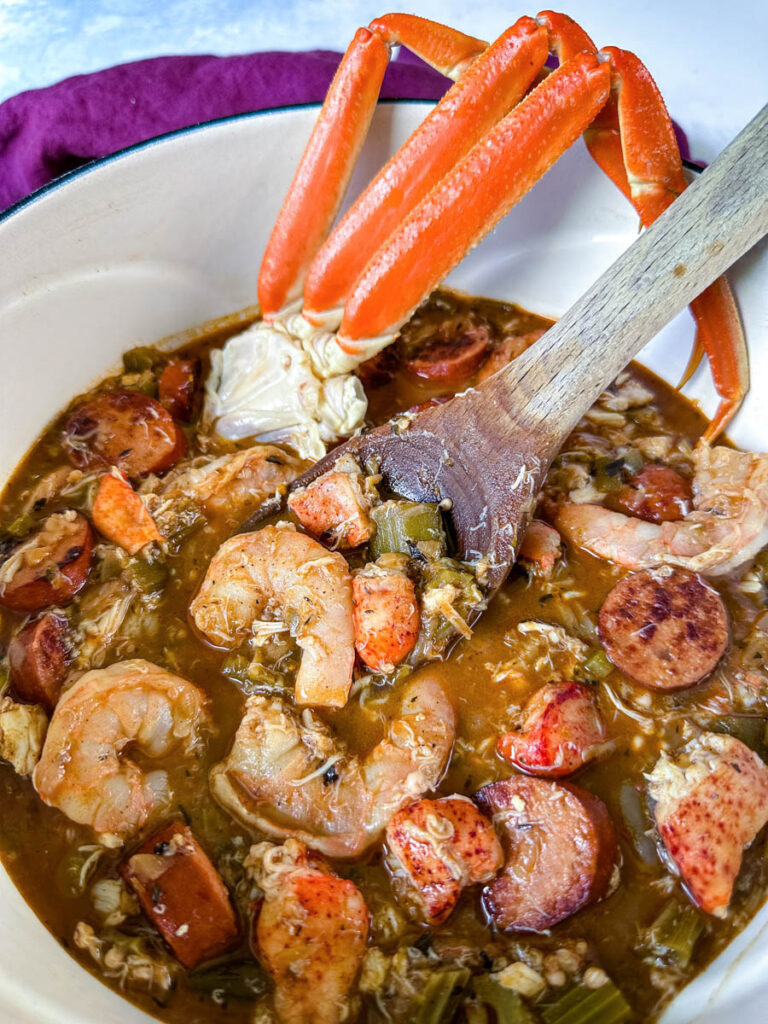
Tomatoes
Tomatoes in gumbo is usually a hot topic among Southerners and native Louisianans. My family is from Louisiana. So trust me, I know! I have had gumbo with and without tomatoes and they are both delicious. It's up to you if you wish to add them to the dish.
There are many authentic Creole versions that include tomatoes, typically diced tomatoes. I also notice tomatoes more commonly in chicken gumbos throughout the South. It will create a slightly different flavor profile.
How to Store Leftovers
Leftovers can be stored tightly covered and sealed for 3-4 days.
How to Reheat
Reheating the dish without overcooking the seafood requires a gentle and careful approach to preserve the textures. Overcooked seafood will taste dry and rubbery.
If you're using the stove, reheat it on low heat only.
If you're using the microwave, reheat in short intervals, 1-2 minutes.
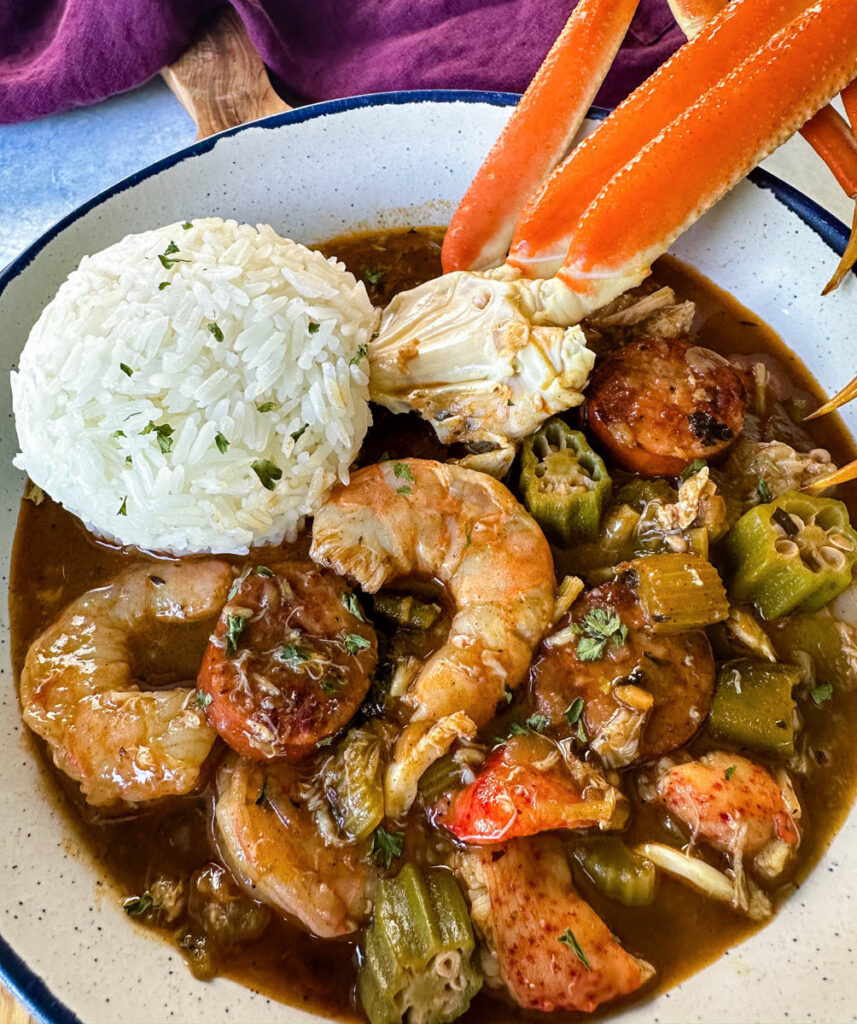
Freezer Tips
You can freeze leftovers tightly sealed and covered for 3-4 months. Defrost overnight in the fridge and reheat as directed above.
Pair With These Recipes
Southern Soul Food Cornbread
Cheddar Jalapeno Cornbread
Southern Collard Greens with Smoked Turkey
Southern Soul Food Creamed Corn
More Cajun Recipes
Southern Red Beans and Rice
Seafood Jambalaya with Shrimp
Cajun Jambalaya Soup
Cajun Dirty Rice
Cajun Fries
Cajun Chicken Wings
Cajun Crawfish Boil
Cajun Shrimp Boil
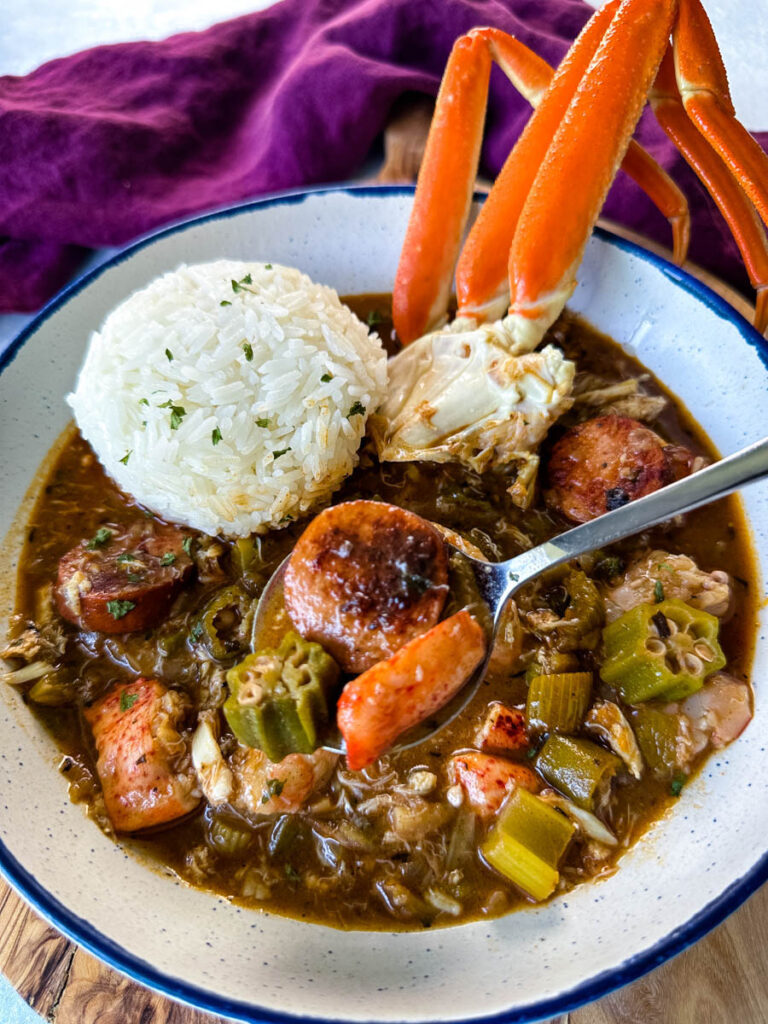
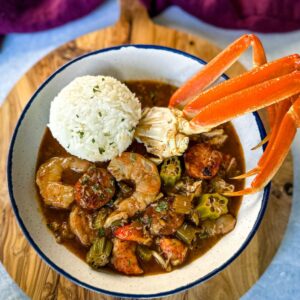
Cajun Seafood Gumbo with Shrimp and Crab
Want to save this recipe for later?
Equipment
Ingredients
- 8 oz andouille sausage Sliced into rounds 1-1 ½ inches thick.
- 5 tablespoons butter
- 4 tablespoons all-purpose flour
- 1 cup diced green peppers
- 1 cup diced celery
- 1 cup diced onions I use white onion.
- 2-3 garlic cloves Minced
- 2-3 cups chopped okra Fresh or frozen. I used 2 cups. Use more for thicker gumbo.
- 24 oz seafood or chicken broth/stock
- 1 pound raw shrimp Peeled and deveined.
- 1 pound lump crab or snow crab legs I like to use a combo of both.
- 8 oz lobster meat Optional
- cooked rice Optional
Herbs and Spices
- 1 teaspoon dried basil
- 1 teaspoon ground oregano
- ½ teaspoon ground thyme
- 1 tablespoon worcestershire sauce
- 1 bay leaf
Homemade Cajun Seasoning (You can also use ½-1 tablespoon of a store-bought blend)
- 1 teaspoon smoked paprika
- ½ teaspoon cayenne pepper Adjust to suit your taste.
- ⅛ teaspoon ground white pepper
- ⅛ teaspoon ground black pepper
- salt to taste I save this for the end and when the dish is fully cooked. Taste repeatedly and adjust as necessary.
Instructions
- Add the sliced sausage to a Dutch oven (mine is 6quart) or stockpot on medium-high heat. Cook for 3-4 minutes on both sides. Remove the sausage from the pot and set aside.
- You will notice brown bits from the sausage at the bottom of the pot. I leave these in for flavor, they will get deglazed during the roux-making process.
- Add the butter to the pot on medium heat. While it melts add the flour in 3 phases. Add the first phase and whisk. Add the second phase, and so on.
- Continue to stir until the roux turns deep brown. It should turn brown within several minutes of stirring. This is the most important step of the recipe and it requires patience. If you stop stirring before it reaches deep brown, it will cake up and/or burn. This takes me 15 minutes.
- Add the green peppers, celery, onions, Worcestershire sauce, and spices (except the bay leaf) to the roux. Stir and cook for 8-10 minutes until the veggies are soft.
- Add in the broth and okra. Stir. Adjust the heat on the stove and bring the pot to boiling.
- Stir and add the bay leaf. Cover the pot. Adjust the heat to low and simmer for 20-30 minutes.
- If you want really soft vegetables, this may take longer. Celery requires the most time to soften. If you don't want celery with a crunch, cook it until it's completely softened.
- Remove the lid from the pot and add the raw shrimp, crab meat, and optional lobster. Cook for 2-3 minutes or until the shrimp is fully cooked and opaque.
- Cool before serving.
Notes
- Seafood cooks fast. Be careful not to overcook it. This is why you don't add it while the gumbo simmers.
- Cooked shrimp tend to curl into a “C” shape. As they cook, the proteins contract, causing the shrimp to curl. When they are tightly curled in an O shape they are typically overcooked.
- Feel free to use any type of seafood you like.
- You can substitute butter with olive oil or vegetable oil if preferred.
- If you want to add chicken you will need to cook the dish for 2 hours or more until tender and fully cooked.
- The shade of brown the roux needs to be is always a source of debate. Many prefer a lighter, peanut butter brown hue. A lot of people prefer a really dark brown hue. When making gumbo and etouffée, I have made it both ways.
- Prepare it based on what you like. A peanut butter brown roux will take 5-6 minutes of stirring. A deep brown roux (as shown in the photos of this recipe) will take you 10 minutes or more.
- I have no suggestions for okra substitutions because okra is essential to the dish and a must for authentic gumbo. It adds flavor, but it’s mostly praised for being a thickener. Okra will give the gumbo a rich and thick texture. A lot of people don’t like okra because of its slimy texture. When you cook it for a long time in a recipe like this one, it isn’t slimy anymore.
- I don't recommend the slow cooker for this one because seafood cooks so fast.
Nutrition
Nutrition Data
Macros are provided as a courtesy and should not be construed as a guarantee. This information is calculated using MyFitnessPal.com. To obtain the most accurate nutritional information in a given recipe, you should calculate the nutritional information with the actual ingredients used in your recipe, using your preferred nutrition calculator. You are solely responsible for ensuring that any nutritional information provided is accurate, complete, and useful.

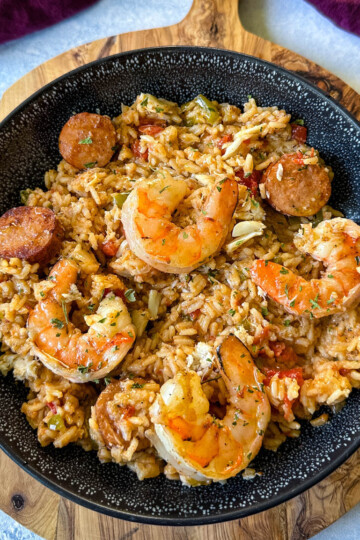
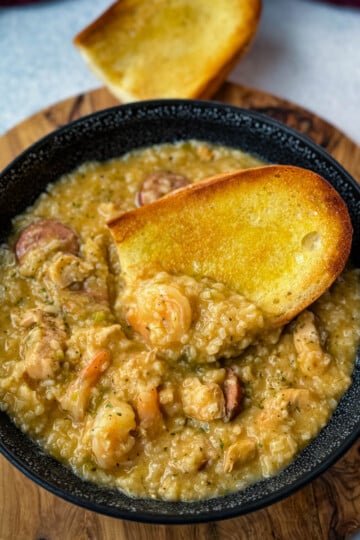
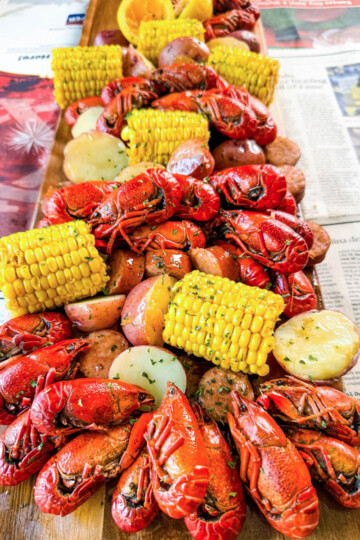
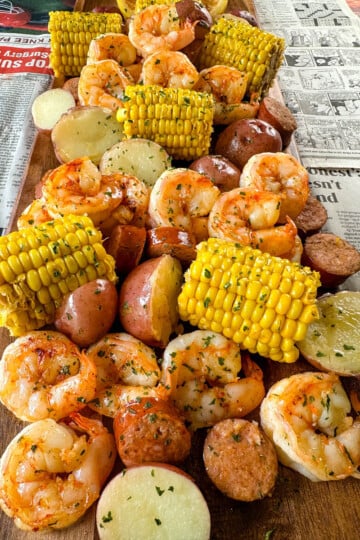
Pat says
In Arcadian the word gumbo translates to the word okra. It was the Arcadian's that introduced gumbo to Louisiana from Quebec. It then became widely known as Creole in language and it's food tradition.
Kevin Griffin says
Great recipes 👌
staysnatched says
Thank you!